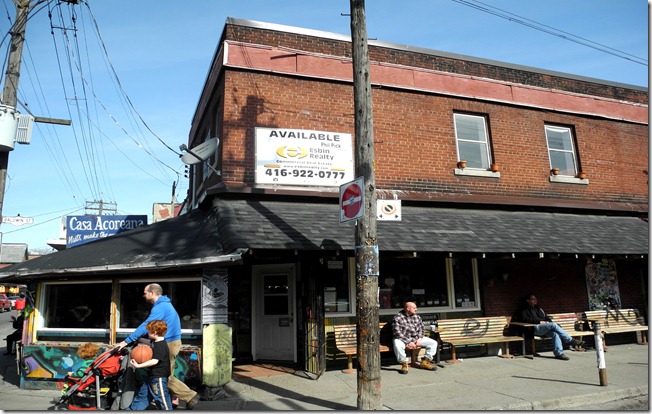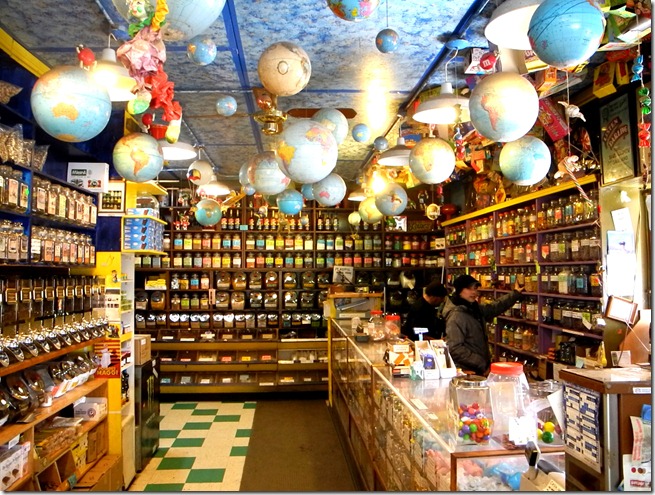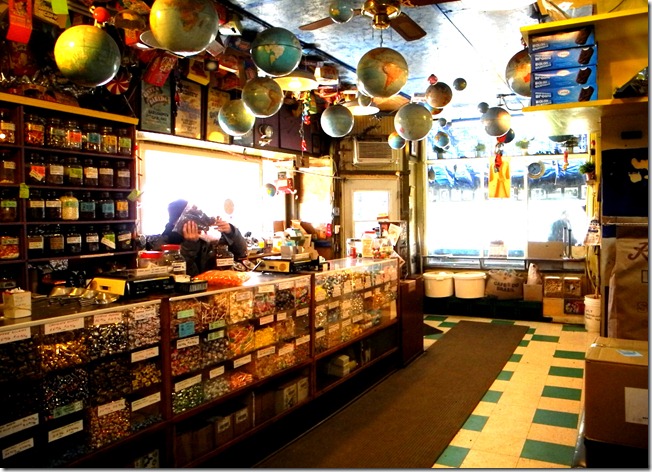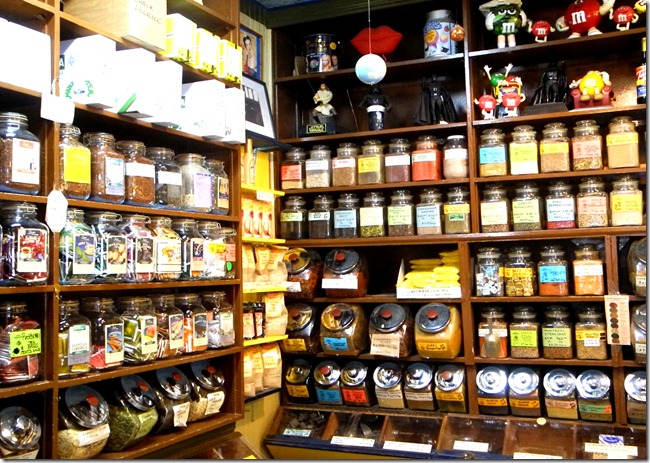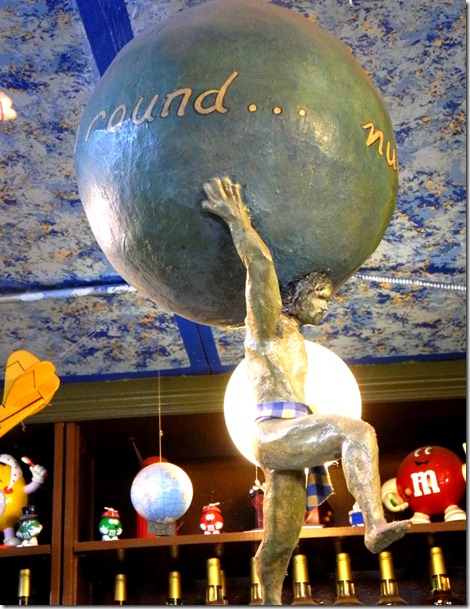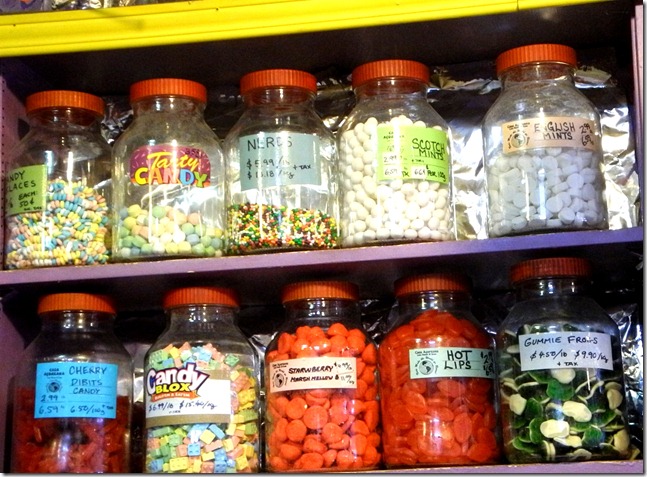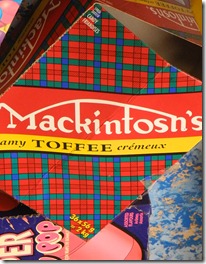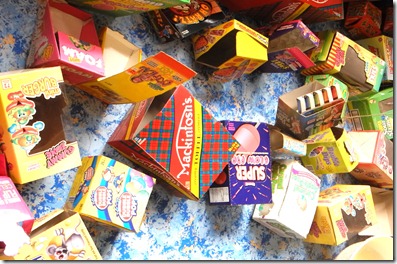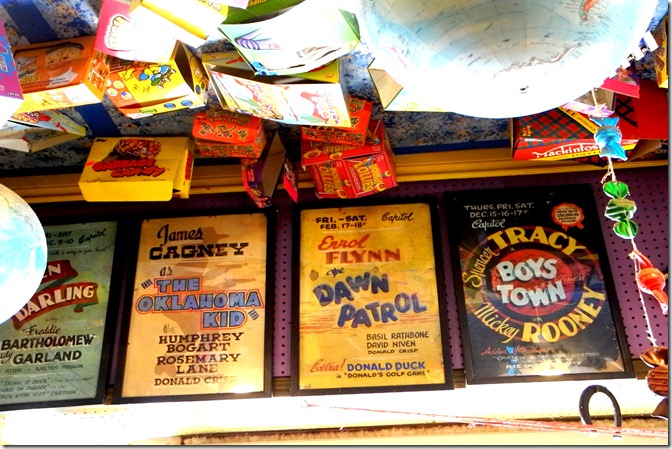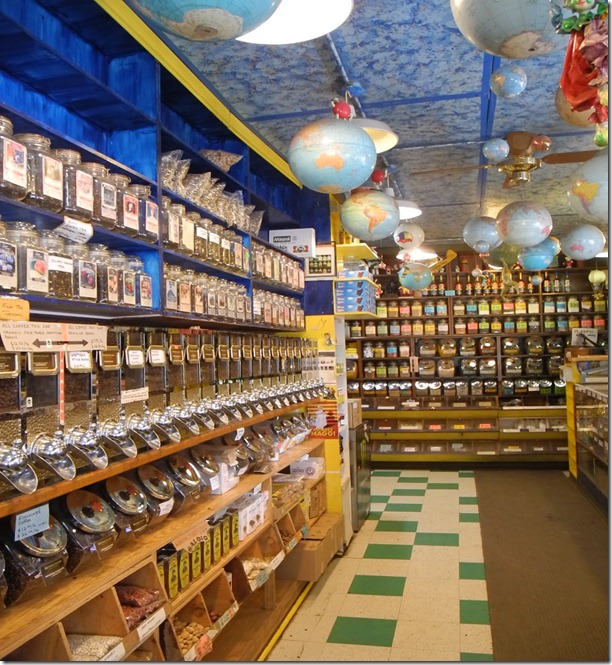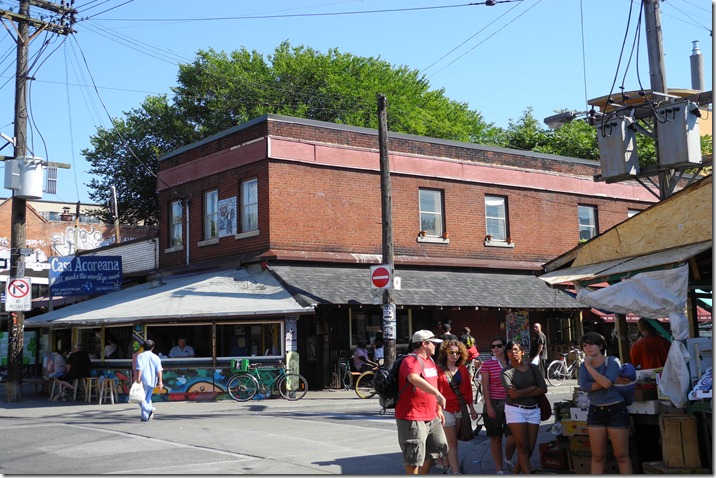I was truly saddened when I saw the real estate sign on the building that houses the Casa Acoreana on the northeast corner of Baldwin Avenue and Augusta Street, in Toronto’s Kensington Market. The unadorned building gives no hint of the treasures contained within its wall. I have shopped here for the past twelve years. Each time I enter the shop I marvel at the array of spices, lentils, teas, candies, and myriad of other products from around the world that are contained in the large glass jars and bins that grace the walls of this exceptional store. Because of the rise in rental costs, it will no longer be possible for the shop-keepers to continue their business. This is a true loss to the city. If you have never been inside the premises—rush—hurry—stampede—to the Market and enter this shop to view the magical array of exotic scents and products. You will never again see another shop like it in the city.
The interior of Casa Acoreana, early on a Saturday morning. The ceiling has globes that show the continents and nations where the products originated.
View from the east wall, gazing west toward Augusta Avenue. This is a shop that makes the penny-candy stores of my youth appear anaemic.
The display of spices and herbs, as well as the assortment of rice and beans, has been raised to an art form.
Sculpture hanging from the ceiling delights the eye.
Candy, though no longer a penny, holds as much fascination for me now, as when I was a child. Alas, even the humble penny is gone. Where will we now purchase our “Hot Lips,” Gummie Frogs, “ and “Strawberry marsh mellows?”
Anyone remember the boxes of Mackintosh Toffee, the ones we smashed into pieces by banging them on the heads of the kids in the row ahead of us at the Saturday afternoon movie matinee? These old-time candy boxes are attached to the ceiling of the Casa Acoreana.
Old movie posters also adorn the walls of the shop.
Casa Acoreana, one of the city’s greatest treasures.
Casa Acoreana in the summer of 2012
The building containing Casa Acoreana is one of the largest in the Kensington Market. It was originally the grocery store of L. Drilleck, whose business was taken over by Max Katz in 1924. Max remained here until 1929, and then relocated to 195 Baldwin Street. The building was empty until 1930, when Norman Young opened a store that sold dairy products. This same year, they altered the south facade of the building to create several small shops, which today still face Baldwin Street. They sell an assortment of Latin American products.
Casa Acoreana proudly declares on its sign—“Nuts make the world go round.” We assume that this is not a political statement. Luis Pavao commenced the business in 1955, and today, it remains a family enterprise, now operated by his sons and a grandson. The store exhibits an excellent display of nuts, and has one of the city’s finest assortments of rice. The odour of the spices fills the interior. Chocolate and dried fruits are also sold. The shelves extend to the ceiling, which is fourteen feet high. A long pole with a pincer on the end, capable of gripping objects, is required to retrieve bottles or jars from the top shelves. The assortment of candies, once referred to as “penny candy,” is in large glass jars, and is one of the best assortments in all of Toronto. The collection of spices is so complete that a visitor from the United States who was unable to purchase two rare spices in either New York or San Francisco, located them at Casa Acoreana.
On the northeast corner of Casa Acoreana is a small outdoor cafe named “Louie’s Kaffe.” Although the owners are Portuguese from the Azores, the small coffee shop seems reminiscent of the stalls found in the eastern Mediterranean lands, particularly in Greece or North Africa. Patrons sit on the stools placed out on the sidewalk, and sip strong coffee while they discuss the events of the day. There is a curved bench on the Augusta side of the café where it is possible to sit and watch the world go by. No other spot in the Market has the atmosphere of this small establishment. Though it is open to the elements, it is busy all winter long. On winter mornings, patrons huddle on the stools to engage in their favourite morning ritual—“coffee and conversation.”
The above is from the book, “The Villages Within,” which contains a detailed study of the history of the buildings of Kensington Market.
For a link to this book: https://tayloronhistory.com/the-villages-within/
To view the Home Page for this blog: https://tayloronhistory.com/
A link to a previous blog about Casa Acoreana:
https://tayloronhistory.com/2013/03/06/torontos-architectural-gemsthe-entire-kensington-market/
To view other posts about the history of Toronto and its buildings:
The Bishop’s (St, Michael’s) Palace on Church Street, Toronto
https://tayloronhistory.com/2013/03/02/torontos-architectural-gemsbishops-palace-on-church-street/
The Ed Mirvish (Pantages, Imperial, Canon) Theatre, a true architectural gem on Toronto’s Yonge Street
The Waverly Hotel on Spadina near College Street.
https://tayloronhistory.com/2013/02/16/toronto-architectural-gemsthe-waverly-hotel-484-spadina/
The Art Deco Bank of Commerce building on King Street West.
The Postal Delivery Building, now the Air Canada Centre (ACC)
The Bellevue Fire Station on College Street
https://tayloronhistory.com/2013/02/14/torontos-architectural-gems-bellevue-fire-station/
The Bank of Nova Scotia at King and Bay Streets
Toronto’s old Sunnyside Beach
https://tayloronhistory.com/2013/02/01/a-pictorial-journey-to-sunnyside-beach-of-old-part-one/
https://tayloronhistory.com/2013/02/03/a-pictorial-journey-to-torontos-old-sunnyside-beach-part-two/
Toronto’s architectural gems—the Runnymede Library
https://tayloronhistory.com/2013/02/05/torontos-architectural-gems-runnymede-library/
Spadina Avenue – sinful, spicy and diverse
https://tayloronhistory.com/2012/09/28/sinfully-saucy-and-diversetorontos-spadina-avenue/
The Reading Building, a warehouse loft on Spadina Avenue
https://tayloronhistory.com/2013/01/20/torontos-architectural-gemsthe-reading-building-on-spadina/
The Darling Building on Spadina Avenue
https://tayloronhistory.com/2013/01/19/torontos-architectural-gemsthe-darling-building-on-spadina/
The amazing Fashion Building on Spadina Avenue
Toronto’s architectural gems – the Tower Building at Spadina and Adelaide Street
The Balfour Building at 119 Spadina Avenue
The Robertson Building at 215 Spadina that houses the Dark Horse Espresso Bar
An architectural gem – Grossman’s Tavern at Spadina and Cecil Streets
https://tayloronhistory.com/2012/11/08/architectural-gem-grossmans-tavern-at-377-9-spadina/Historic
History of the house that contains the Paul Magder Fur Shop at 202 Spadina
An important historic building that disappeared from the northeast corner of Spadina and College
Historic bank building on northeast corner of Spadina and Queen West
https://tayloronhistory.com/2012/12/02/torontos-architectural-gemsbank-at-spadina-and-queen-west/
History of the Backpackers’ Hotel at King and Spadina
https://tayloronhistory.com/2012/03/31/history-of-the-backpackers-hotel-at-king-and-spadina/
Hamburger corner – Spadina and Queen Streets
https://tayloronhistory.com/2012/10/10/torontos-hamburger-cornerwhere-is-it-and-why/
Lord Lansdowne Public School on Spadina Crescent
The Victory Burlesque Theatre at Dundas and Spadina
https://tayloronhistory.com/2012/09/08/the-sinful-victory-burlesque-theatre-at-dundas-and-spadina/
The Dragon City Mall on the southwest corner of Dundas and Spadina
https://tayloronhistory.com/2012/08/25/torontos-heritage-the-southwest-corner-of-queen-and-spadina/
Buildings on the west side of Spadina a short distance north of Queen Street.
History of the site of the Mcdonalds on northwest corner of Queen and Spadina
https://tayloronhistory.com/2012/08/27/mcdonalds-at-queen-and-spadina-on-an-historic-site/
A former mansion at 235 Spadina that is now almost hidden from view.
ttps://tayloronhistory.wordpress.com/2012/07/04/torontos-architectural-gems-is-this-one-a-joke/
Military hero of the War of 1812 lived near corner of Spadina and Queen West.
To view other posts about Toronto’s past and its historic buildings:
The Art Deco bus terminal at Bay and Dundas Streets.
Photos of the surroundings of the CN Tower and and the St. Lawrence Market in 1977
The old Dominion Bank Building at King and Yonge Street
The Canada Life Building on University and Queen Street West.
Campbell House at the corner of Queen Street West and University Avenue
A study of Osgoode Hall
https://tayloronhistory.com/2012/04/12/enjoying-torontos-architectural-gems-osgoode-hall/
Toronto’s first City Hall, now a part of the St. Lawrence Market
Toronto’s Draper Street, a time-tunnel into the 19th century
The Black Bull Tavern at Queen and Soho Streets, established in 1822
History of the 1867 fence around Osgoode Hall on Queen Street West at York Street
Gathering around the radio as a child in the 1940s
The opening of the University Theatre on Bloor Street, west of Bay St.
https://tayloronhistory.com/2012/02/24/the-opening-of-torontos-university-theatre-on-bloor-street/
122 persons perish in the Noronic Disaster on Toronto’s waterfront in 1949
Historic Victoria Memorial Square where Toronto’s first cemetery was located, now hidden amid the Entertainment District
https://tayloronhistory.com/2012/01/09/victoria-square-in-torontos-entertainment-district-is-a-gem/
Visiting one of Toronto’s best preserved 19th-century streets-Willcocks Avenue
The 1930s Water Maintenance Building on Brant Street, north of St. Andrew’s Park
Toronto’s architectural gems-photos of the Old City from a book published by the city in 1912
Toronto’s architectural gems in 1912
https://tayloronhistory.com/2012/12/04/torontos-architectural-gems-in-1912/
Toronto’s architectural gems – the bank on the northeast corner of Queen West and Spadina
https://tayloronhistory.com/2012/12/02/torontos-architectural-gemsbank-at-spadina-and-queen-west/
Photos of the surroundings of the CN Tower and and the St. Lawrence Market in 1977
The St. Lawrence Hall on King Street
https://tayloronhistory.com/2012/04/28/enjoying-torontos-architectural-gems-the-st-lawrence-hall/
Toronto’s streetcars through the past decades
https://tayloronhistory.com/2012/03/26/memories-of-torontos-streetcars-of-yesteryear/
History of Trinity Bellwoods Park
https://tayloronhistory.com/2012/04/09/the-history-and-beauty-of-trinity-bellwood-park/
A history of Toronto’s famous ferry boats to the Toronto Islands
Toronto’s Old City Hall at Bay and Queen Streets
https://tayloronhistory.com/2012/04/22/enjoying-torontos-architectural-gems-old-city-hall/
